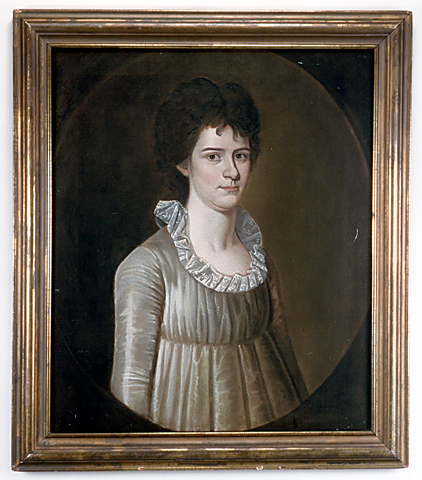| Maker(s): | Jennys, Richard | | Culture: | American (ca. 1734-1809)
| | Title: | Peggy Ashley
| | Date Made: | ca. 1800
| | Type: | Painting
| | Materials: | oil on canvas, wood, gilding
| | Place Made: | United States; Massachusetts; Westfield
| | Measurements: | frame: 29 x 24 1/2 in.; 73.66 x 62.23 cm
| | Accession Number: | HD 2001.11
| | Credit Line: | Peterson Fund for Paintings, Prints, Drawings, and Photographs
| | Museum Collection: | Historic Deerfield
|
|

|
Description:
Oil portrait of Miss Peggy Ashley (1780-1833) in a grey/off-white Empire-style dress. Her half-length portrait is painted in a darkened roundel, and show the young girl with brown hair parted in the middle and brown eyes. She wears a scoop-neck dress with a white lace ruffle and shiny, silk-like material. There is a paper label attached to the back stretchers: "Miss Ashley born in Westfield Mass about 1780 she did the sampler 1793 [whereabouts unknown], Ex. Boston Mass. Museum of Fine Arts, Portrait...Ashley by Wm Jennys 21.63 lent by Mr. and Mrs. P. Knost." According to the "Ashley Genealogy", Margaret or "Peggy" Ashley was the daughter of Dr. Israel Ashley (1747-1814) and Mary Gelston Ashley of Westfield, and she married Capt. Lyman Lewis (1776-1822) of Westfield in 1805. Jennys also painted Peggy's parents, Israel and Mary Ashley and her sister Mary (Pretty Polly) Ashley and her husband Elizah Bates (portraits in the RISD collection), and Peggy's brother Thomas (1788-1870) (portrait last seen at Ron Bourgeault's Northeast Auctions, Nov. 1-2, 1997). William Jennys (the attributed artist on the paper label) and his father Richard Jennys (c.1734-1809) travelled for sixteen years as itinerant portrait painters between 1792/3 and 1809. The first seven years was mainly centered around New Milford, Connecticut, but William was in NYC long enough to be listed as a portrait painter in the 1797/8 directories. By 1800, they painted mostly in western and central Massachusetts, with trips to several towns in Vermont and New Hampshire; and between 1804-1809, they were centered in Newburyport, Massachusetts. While both Richard and his son's works are quite similar, William's can often be discerned by a stronger delineation of facial features and a more intense, single light source from one side.
Tags:
portraits Subjects:
Canvas; Portraits Link to share this object record:
https://museums.fivecolleges.edu/detail.php?t=objects&type=ext&id_number=HD+2001.11 |